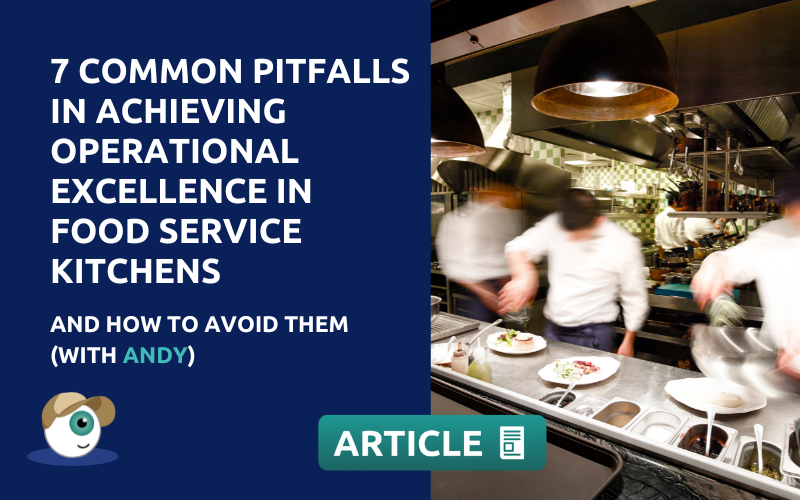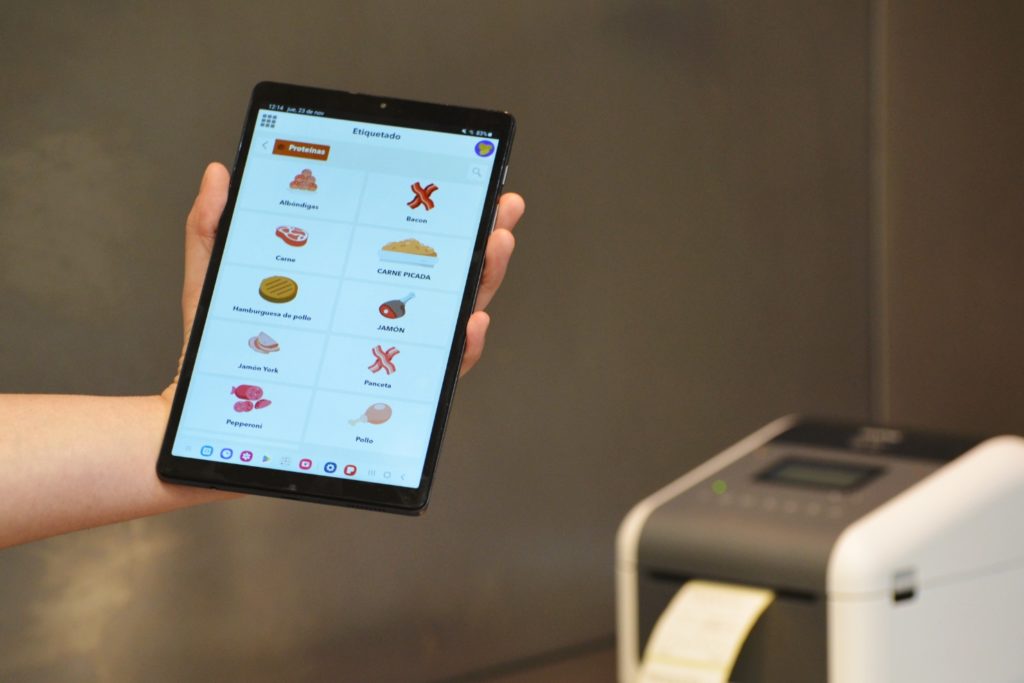7 common pitfalls in achieving operational excellence in food service kitchens – and how to avoid them

All food service businesses – regardless of size – launch into the competitive hospitality landscape aiming to achieve excellence in all their operations.
Without excellence, it’s hard – if not impossible – to maintain high standards of service, ensure food safety, maximise efficiency, and obtain the expected financial results.
However, there are common but often disregarded pitfalls that can hinder this goal.
Addressing these issues through strong leadership, fostering a culture of continuous improvement, and investing in training and technology can help avoid them.
Today, we’d like to explore five common pitfalls and how to avoid them, along with how digital food safety and operational excellence digital assistant Andy can help prevent and control these challenges.
7 common pitfalls in achieving operational excellence in food service kitchens
-
Lack of Standardisation
Pitfall: One of the most significant barriers to operational excellence is the lack of standardisation in processes and procedures. Without consistent methods, it becomes difficult to maintain quality, ensure efficiency, and train new staff effectively. Variability in cooking techniques, ingredient measurements, and plating can lead to inconsistent food quality and customer dissatisfaction.
Solution: Implementing standard operating procedures (SOPs) is essential. SOPs provide clear, detailed instructions for every task in the kitchen, ensuring consistency across shifts and staff members. Regular training and refresher courses can help maintain these standards.
Additionally, adopting checklists and routine audits can ensure that standards are being followed consistently.
-
Poor Communication
Pitfall: Effective communication is the backbone of a well-functioning kitchen. Poor communication can lead to misunderstandings, mistakes, and delays, ultimately affecting the quality of service and customer satisfaction. Miscommunication about orders, special dietary needs, or inventory levels can create chaos during service hours.
Solution: Establishing clear communication channels and protocols is crucial. This can be achieved through pre-shift meetings, post-shift debriefs, and using technology like Andy to streamline order management and internal communication amongst teams and their leaders.
Encouraging an open and inclusive communication culture where staff feel comfortable voicing concerns and suggestions can also improve overall efficiency.
-
Resistance to Change
Pitfall: Resistance to change is a common issue in many workplaces, including kitchens. Staff may be hesitant to adopt new technologies, procedures, or menu changes due to fear of the unknown or attachment to traditional methods. This resistance can stifle innovation and hinder improvements in efficiency and quality.
Solution: Addressing resistance to change requires strong leadership and effective change management strategies. Involving staff in the decision-making process, providing thorough training on new systems, and clearly communicating the benefits of changes can help ease transitions.
Celebrating small wins and showing how changes positively impact daily operations can also build support for new initiatives.
-
Inefficient Inventory Management
Pitfall: Poor inventory management can lead to overstocking, understocking, and increased food waste, impacting both the kitchen’s efficiency and its bottom line. Without accurate tracking and labelling, kitchens may run out of essential ingredients or have excess stock that spoils before it can be used.
Solution: Implementing an inventory management system is key to optimising stock levels. These systems can track inventory in real-time, predict usage patterns, and alert staff when items need to be reordered.
Regular audits and FIFO (First In, First Out) practices can also help reduce waste and ensure that ingredients are used efficiently.
Most importantly, Andy’s food labelling tool helps keep primary and secondary expiry dates under control, ensuring traceability and reducing the risk of using expired ingredients. By automating the labelling process, Andy’s tool can handle these tasks much faster and more efficiently than manual methods, eliminating the need for paper-based tracking.
This not only frees employees from the tedious task of manually labelling and tracking inventory but also significantly reduces human error. The automated system provides real-time updates and alerts, helping to maintain optimal inventory levels and saving money by minimising food waste.
The increased efficiency and accuracy lead to substantial cost savings and a more streamlined kitchen operation.

-
Inadequate Training and Development
Pitfall: Inadequate training can lead to mistakes, inefficiencies, and high staff turnover. Without proper training, staff may struggle to perform their duties effectively, impacting the kitchen’s overall performance and customer satisfaction.
Solution: Investing in comprehensive training and development programs is essential. This includes initial training for new hires, ongoing training for existing staff, and opportunities for professional development.
Cross-training staff on multiple roles can also enhance flexibility and ensure that the kitchen runs smoothly even during staff shortages.
-
Poor Maintenance
Pitfall: Neglecting regular maintenance of kitchen equipment can lead to breakdowns, inefficiencies, and safety hazards – all great enemies of operational excellence in food service kitchens. Faulty equipment can slow down operations, lead to inconsistent food quality, and increase the risk of accidents.
Solution: Establish a preventative maintenance schedule to ensure that all equipment is regularly inspected, cleaned, and serviced. Investing in high-quality equipment and keeping a maintenance log in Andy can help track the condition of appliances and address issues before they become major problems.
Additionally, training staff on the proper use and care of equipment can extend its lifespan and improve operational efficiency.
-
Poor HACCP Control
Pitfall: Failure to effectively implement and manage Hazard Analysis and Critical Control Points (HACCP) can lead to food safety issues. Without proper HACCP control, kitchens may not identify potential hazards, leading to contamination and foodborne illnesses.
Solution: Implementing a robust HACCP plan is essential for food safety. This involves identifying critical control points (CCPs), setting up monitoring procedures, and establishing corrective actions for when CCPs are not met.
Regular training for staff on HACCP principles and protocols is crucial.
Andy can guide teams in food service kitchens while streamlining HACCP monitoring and documentation, ensuring compliance with food safety regulations and providing real-time alerts for potential issues.
Achieving operational excellence in food service kitchens is a multifaceted challenge that involves addressing common pitfalls such as lack of standardisation, poor communication, resistance to change, inefficient inventory management, inadequate training, poor maintenance, and poor HACCP control.
While traditional methods can partially address these issues, the integration of a digital assistant like Andy significantly enhances the effectiveness and efficiency of these solutions.
Andy’s digital tools and features streamline various kitchen operations – from HACCP management to food labelling, maintenance control and a lot more, ensuring tasks are performed consistently and accurately.
- For instance, Andy’s labelling tool can automate inventory management by tracking primary and secondary expiry dates, ensuring traceability, and reducing food waste.
- Andy facilitates better communication and training through digital training and documentation tools, making essential information readily accessible and ensuring staff are always up-to-date.
- Andy’s maintenance scheduling feature ensures regular equipment checks and preventive maintenance, preventing breakdowns and extending the lifespan of kitchen appliances.
- Lastly, Andy’s digital HACCP control system offers real-time monitoring and alerts, ensuring compliance with food safety standards and preventing potential hazards.
By adopting a digital assistant like Andy, kitchens can not only avoid these common pitfalls but also achieve a higher level of operational excellence in food service, ensuring consistent quality, efficiency, and safety in their operations.

